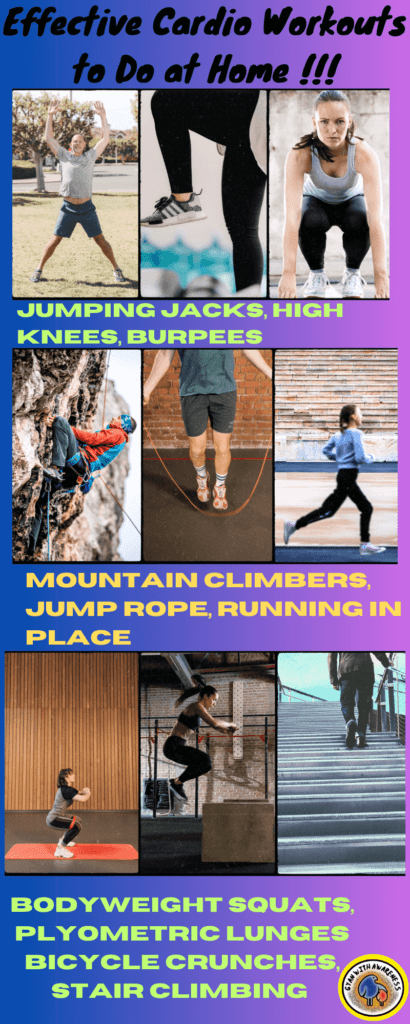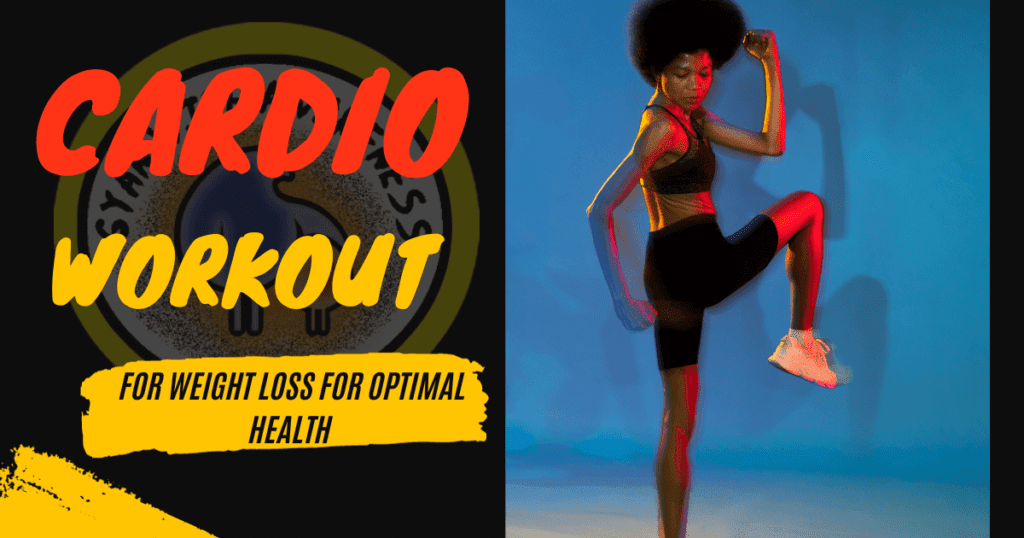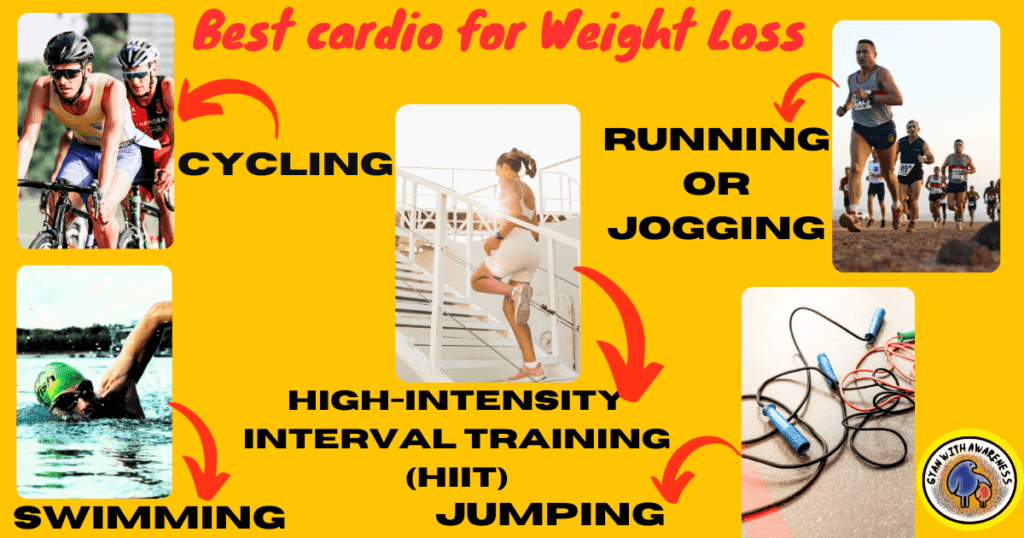A balanced strategy involving both exercise and a healthy diet is necessary to start along the path to weight loss and optimal health. Cardiovascular exercises stand out among the variety of fitness routines as effective methods for reaching these objectives. Exercises that increase cardiovascular health, increase metabolism, and promote general well-being also help burn calories. This comprehensive guide will outline the 21 best cardio exercises designed to help you lose weight and live a better, more energetic life.
From high-intensity interval training (HIIT) to endurance-building activities, each workout offers a unique approach to elevating heart rate, burning calories, and igniting the body’s natural fat-burning mechanisms. Whether you’re an avid gym-goer or prefer the comfort of home workouts, we’ve curated an array of exercises suitable for all fitness levels. Join us on this journey to explore dynamic cardio routines that not only shed pounds but also cultivate a strong foundation for enduring health. Get ready to revitalize your fitness journey with these invigorating cardio workouts.
Our lifestyles have undergone a significant transition in the fast-paced world of today. Modern conveniences and facilities have encouraged increased sedentary behaviors while promoting processed foods and erratic eating patterns. Several health problems, including obesity, heart disease, and diseases linked to stress, have unluckily been brought on by this transition.
Cardiovascular exercise plays a pivotal role in combating these modern-day health challenges. Engaging in regular cardio workouts, such as brisk walking, running, or cycling, not only helps in shedding excess weight but also improves heart health, lowers blood pressure, and enhances overall fitness levels. Moreover, cardio exercises release endorphins, the body’s natural mood elevators, which aid in reducing stress and anxiety—a prevalent concern in our fast-paced lives.
Cardiovascular exercise helps us actively combat the negative impacts of contemporary lives. It promotes a comprehensive approach to health by boosting energy levels, metabolism, and mental well-being. Prioritizing cardiovascular fitness becomes crucial for regaining our well-being and thriving in today’s demanding society as we navigate this dynamic era.
Also Read: Dyspepsia ICD 10 Code, Causes, Symptoms, and Best Treatment
Define Cardio and Its Role in Weight Loss:
Cardio, short for cardiovascular exercise, refers to any type of exercise that increases heart rate and uses plenty of muscles continuously and rhythmically. It aims to make the heart and circulatory system more effective. Cardio exercises include brisk walking, cycling, swimming, and running.
Cardio exercise is essential for weight loss. Consistently doing it causes the body to burn calories and use stored fat as fuel. Cardio exercises boost heart rate and breathing, which increases calorie expenditure. When combined with a healthy diet, this results in a calorie deficit. For weight loss, this shortfall is essential.
Furthermore, aerobic activities increase metabolism, resulting in ongoing calorie burning long after the exercise session is complete. Achieving long-term weight loss objectives depends on this occurrence, sometimes referred to as excess post-exercise oxygen consumption.
In essence, incorporating regular cardio into one’s fitness routine is a cornerstone of an effective weight loss regimen. It not only aids in shedding pounds but also promotes overall cardiovascular health and enhances endurance, contributing to a well-rounded approach to fitness.
Best cardio for Weight Loss:
Running or jogging: A great calorie-burning exercise that uses your entire body. It can be performed on a treadmill or outside.
Cycling: Cycling, whether done outside or on a stationary cycle, uses a lot of muscle groups and is low-impact, making it appropriate for people of all fitness levels.
Swimming is a low-impact, all-over-body exercise. It increases cardiovascular health and burns a lot of calories.
High-Intensity Interval Training (HIIT): Consists of brief bursts of vigorous exercise interspersed with rest periods. HIIT workouts are highly efficient in increasing metabolism and burning calories.
Jumping rope is a vigorous activity that works a variety of muscle groups and speeds up heart rate. It’s a convenient and mobile kind of cardio.
Cardio At Home:
Engaging in cardio exercises at home offers a multitude of benefits for individuals seeking to improve their overall health and well-being. Firstly, convenience reigns supreme. With no need for a commute to a gym, individuals can seamlessly incorporate workouts into their daily routines. This accessibility promotes consistency, a critical factor in achieving fitness goals. Moreover, at-home cardio routines require minimal to no equipment, making it a cost-effective option. From bodyweight exercises to activities like jumping jacks or high knees, there’s a wide array of effective workouts that demand little more than a small space.
Cardio exercises at home provide privacy. Yes, privacy is yet another benefit. For people who might feel uncomfortable in public
gyms, exercising at home offers a cozy and unintimidating atmosphere. Additionally, it enables personalization, letting users select exercises by their preferences and fitness levels. Additionally, at-home cardio acts as a dependable backup in unforeseeable situations, like a global epidemic, guaranteeing that fitness goals can be achieved despite outside interruptions. Overall, establishing a regular at-home cardio regimen can improve emotional and physical well-being, as well as cardiovascular health, resulting in a healthier and more rewarding lifestyle.
Effective Cardio Workouts to Do at Home !!!
Jumping Jacks
High Knees
Burpees
Mountain Climbers
Jump Rope (if space allows)
Running in Place
Bodyweight Squats
Plyometric Lunges
Bicycle Crunches
Stair Climbing (if stairs are available)

1. Jumping Jacks:
How to do:
Stand with your feet together and arms by your sides.
Jump while spreading your legs apart and raising your arms above your head.
Quickly return to the starting position by jumping back and bringing your arms down.
Calories Burned:
Jumping jacks can burn approximately 100-200 calories in 10 minutes, depending on intensity.
Benefits:
Excellent warm-up exercise, gets your heart rate up quickly.
Engages multiple muscle groups, promoting overall strength and coordination.
Boosts cardiovascular endurance.
Helps in weight management and fat loss.
Requires no special equipment, making it a convenient workout option.
2. Burpees:
What to do:
Your feet should be hip-width apart as you stand.
In a flash, raise the other knee after lifting the first one toward your chest.
Lifting your knees as high as you can, keep sprinting.
Calories Burned:
High knees can burn between 150 and 250 calories in ten minutes, depending on their intensity.
Benefits:
Enhances cardiovascular fitness and raises the heart rate.
Promotes strength and stability by involving the lower body and the muscles in the core.
Boosts agility and coordination.
Enhances both speed and running form.
Adapted to meet different levels of fitness.
3. Climbers of mountains:
Start in the plank position. Keep your core engaged as you alternately bring your knees toward your chest to simulate climbing a mountain.
Calories Burned:
Depending on exertion and body weight, mountain climbers can expend 6–10 calories each minute.
Benefits:
Focuses on the shoulders, legs, and core.
Increases heart rate to help the cardiovascular system.
Increases coordination and agility.
Efficiently burns calories.
Makes the body stronger overall.
4. Jump Rope (if space allows):
How to Do:
Hold the jump rope handles, swing the rope over your head, and jump over it as it passes under your feet.
Calories Burned:
Jumping rope can burn approximately 10-15 calories per minute, depending on intensity and body weight.
Benefits:
Excellent for cardiovascular fitness.
Enhances coordination and agility.
Effective calorie burner.
Improves balance and endurance.
Portable and convenient for workouts on the go.
5. Running in Place:
How to Do:
Stand with your feet hip-width apart.
Begin lifting your knees up and down in a running motion while staying in one spot.
Swing your arms naturally in coordination with your leg movements.
Calories Burned:
Running in place can burn about 300-400 calories per 30 minutes, depending on intensity and body weight.
Benefits:
Elevates heart rate for a cardiovascular workout.
Improves lower body strength, especially calves and quadriceps.
Enhances coordination and agility.
Requires no equipment and can be done anywhere.
Can be adapted for various fitness levels.
6. Bodyweight Squats:
How to Do:
Begin by positioning your feet shoulder-width apart.
Initiate the movement by lowering your body, bending your knees, and pushing your hips back. Keep your chest upright throughout.
Continue the descent until your thighs are parallel to the ground.
Push through your heels to return to the starting position.
Calories Burned:
Bodyweight squats can lead to the expenditure of approximately 5-8 calories per minute, contingent on the intensity and individual body weight.
Benefits:
Strengthens key lower body muscles including the quadriceps, glutes, and hamstrings.
Enhances functional fitness, augmenting your ability to perform everyday movements with ease.
Easily adaptable for individuals of varying fitness levels.
Demands no special equipment and can be executed in any suitable space.
Aids in sculpting and toning the legs and buttocks, contributing to an improved lower body aesthetic.
7. Jumping Lunges:
What to Do:
Lunge forward with one foot and back with the other.
Suddenly jump up and change your leg placements while in the air.
The back knee should be bent when you land, then quickly repeat with the other foot in front.
Calories Burned:
Depending on effort and body weight, plyometric lunges can burn 8–12 calories per minute.
Benefits:
Utilizes both cardio and strength for a strong workout.
Key muscle groups are worked, resulting in calorie burning.
Strengthens the lower body, particularly the quads, glutes, and calves.
Improves agility and explosive power.
Increases metabolism for sustained calorie burning after exercise.
8. Cycling crunches:
What to Do:
Lay on your back with your elbows out to the sides and your hands behind your head.
As you lift your legs, bend your knees to a 90-degree angle.
While stretching your right leg out, alternately bring your right elbow and left knee toward one another.
In a pedaling action, switch sides by bringing your left elbow up to your right knee.
Calories expended:
Depending on effort and body weight, bicycle crunches can burn between 8 and 12 calories per minute.
Benefits:
Focuses on the rectus abdominis and obliques as well as other abdominal muscles.
Increases stability and core strength.
Increases torso flexibility and range of motion.
Engages several muscular groups, which encourages calorie burning.
Has no equipment requirements and is portable.
9. Stair Climbing (if stairs are available):
How to Do:
Locate a set of stairs or a staircase.
Begin by stepping up with your right foot, followed by your left.
Continue this motion, ascending the stairs in a controlled manner.
Descend by stepping down with your right foot first, followed by your left.
Calories Burned:
Stair climbing can burn approximately 7-11 calories per minute, depending on intensity and body weight.
Benefits:
Provides a vigorous lower body workout, targeting muscles in the legs, hips, and glutes.
Elevates heart rate for an effective cardiovascular exercise.
Enhances lower body strength and power.
Boosts endurance and stamina.
Requires minimal equipment and can be done in various environments with access to stairs.
10. High Knees:
How to Do:
Arms should be at your sides while you stand with your feet hip-width apart.
Start by jogging stationarily while extending your knees as high as you can with each step.
Swing your arms in unison with raising your legs.
Strive to land softly on the balls of your feet while keeping a quick speed.
Calories Exhausted:
Depending on how intense they are and how much weight you are carrying, high knees can burn between 500 and 700 calories each hour.
Benefits:
Increases heart rate and encourages cardiovascular fitness.
Leg muscles are strengthened as the core muscles are active.
Increases the flexibility and coordination of the lower body.
Efficiently burns calories to help you maintain your weight.
Adaptable for different fitness levels, and may be used in warm-up exercises or intense workouts.
List of Cardio Exercises:
- Running
- Cycling
- Jump Rope
- Swimming
- High-Intensity Interval Training (HIIT)
- CrossFit
- Circuit Training
- Stair Climbing
- Kickboxing
- Rowing
- Plyometrics
- Elliptical Training
- Power Walking
- Dance Aerobics
- Tabata
- Spin Class
- Burpees
- Kettlebell Swings
- Battle Ropes
- Box Jumping
- Sprints

Incorporating home cardio exercises into one’s fitness routine is a commendable choice for achieving and maintaining optimal health. The convenience and accessibility of these workouts eliminate barriers to regular exercise, making it easier to stay committed to fitness goals. Whether it’s brisk walking, bodyweight exercises, or even a session of jump rope, the options are diverse and adaptable to individual preferences and fitness levels.
Cardio activities performed at home have numerous advantages. By fortifying the heart and boosting its capacity to pump blood effectively, they help to promote cardiovascular health. Additionally, these workouts increase calorie burn, improving overall metabolic health and assisting with weight management. Home aerobic workouts are also essential for lowering stress levels, fostering mental health, and elevating mood. Furthermore, people from all walks of life can benefit from these exercises due to their affordability and simplicity.
By integrating home-based cardio exercises, individuals empower themselves to take charge of their health and well-being, fostering a sustainable and fulfilling fitness journey. Remember, consistency is key, and even small, regular efforts can yield significant and lasting benefits.
FAQ:
Which cardio burns the most fat?
High-intensity interval training (HIIT) is typically accepted as the most effective kind of cardio for burning fat. HIIT involves short bursts of intense exercise separated by periods of rest or low-intensity exercise. This approach results in the afterburn effect, commonly known as excessive post-exercise oxygen consumption. The body continues to burn calories at a high rate for several hours after an HIIT workout. As a result, HIIT is quite efficient in burning fat.
Furthermore, HIIT workouts are versatile and can be adapted to various exercises, such as sprinting, cycling, or bodyweight movements like burpees. They can be customized to suit different fitness levels and can be done with minimal equipment or even just body weight. This accessibility, combined with its exceptional fat-burning benefits, has made HIIT a popular choice for individuals seeking efficient and effective cardio workouts.
What is the fastest cardio to lose weight?
High-Intensity Interval Training (HIIT) is the cardio exercise that burns fat the fastest. Short bursts of all-out, intense effort are interspersed with rest or low-intensity activity during HIIT workouts. Compared to steady-state cardio activities, this strategy maximizes calorie burn in a shorter period.
Even after the activity is over, the body continues to need more oxygen when performing HIIT. Excess post-exercise oxygen consumption (EPOC), a phenomenon, is the term used to describe the body’s prolonged increase in calorie burning after exercise. Due to the increased overall calorie expenditure that results, HIIT is a very effective weight loss strategy.
How can I burn 1,000 calories fast?
Incorporate compound Movements: Focus on exercises that engage multiple muscle groups simultaneously, such as squats, deadlifts, and burpees. These demand more energy and thus lead to higher calorie expenditure.
Cardiovascular Intervals: Alternate between high-intensity cardio activities like sprinting, cycling, or rowing, with brief periods of active recovery or low-intensity exercise.
Utilize Resistance Training: Incorporate weightlifting or resistance exercises. Muscle-building activities increase the body’s basal metabolic rate, leading to greater calorie burn even at rest.
What is the laziest way to burn calories?
The laziest way to burn calories involves incorporating small, low-impact activities into daily routines. This includes activities like standing instead of sitting, taking short walks, using stairs instead of elevators, and doing light household chores. While less intensive, these activities contribute to calorie expenditure over time.


2 thoughts on “21 Best Cardio for Weight Loss And Optimal Health”